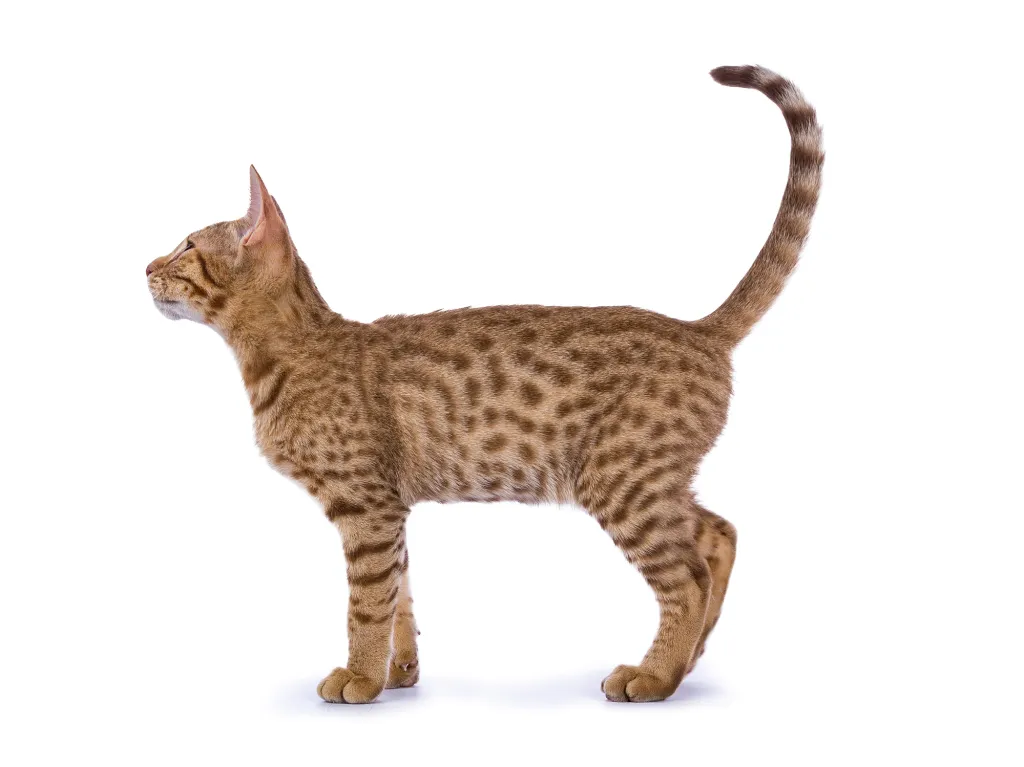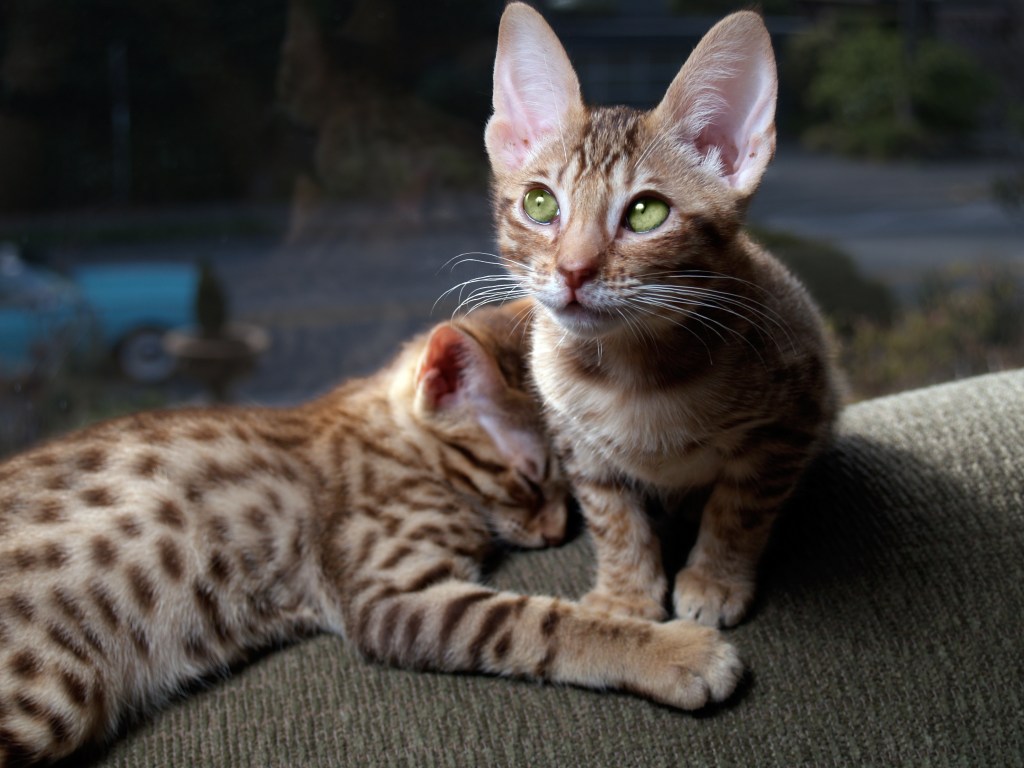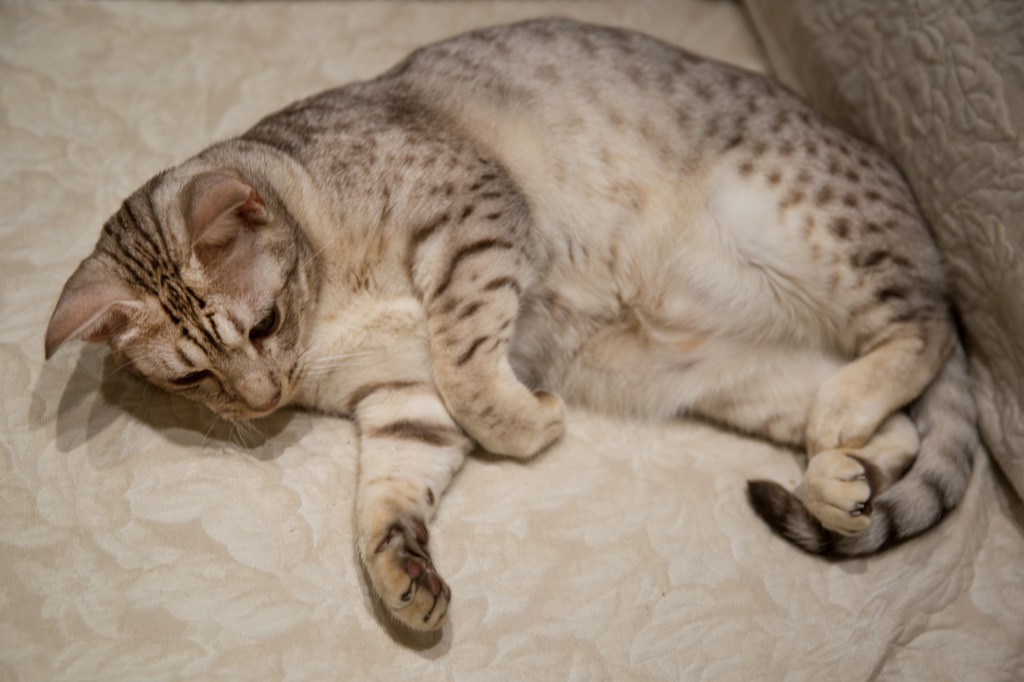The Ocicat stands out among house cats with its wild appearance and lively personality. This breed, which began in the United States, was created by crossing Siamese, Abyssinian, and American Shorthair cats. The result is a breed that looks like an ocelot, a wild spotted cat native to South America, while keeping the friendly and loving nature of a house cat.
Recognized by their almond-shaped eyes, Ocicats have a strong body with a short, spotted coat. The coat patterns look like those of the ocelot, featuring spots or marbled patterns in a variety of colors. Also known for their intelligence and agility, Ocicats are highly interactive and enjoy engaging in activities with their human buddies. They often form strong bonds with their owners and are talkative, using many vocalizations to communicate.
When considering an Ocicat, it’s advisable to prioritize adopting from rescue organizations or shelters to provide a loving home to a cat in need. However, if you decide to purchase an Ocicat kitten, it’s crucial to choose a reputable breeder. Conduct thorough research to ensure that the breeder follows ethical practices and prioritizes the well-being of their cats. Reputable Ocicat breeders prioritize the health and temperament of their cats, conduct necessary health screenings, and provide a nurturing environment for the kitties. This active approach ensures that you bring home a healthy and happy kitty while discouraging unethical breeding practices.
Quick Facts
- Origin: USA (1964), bred from Abyssinian, Siamese, and American Shorthair cats.
- Size: Medium-to-large (8-15 pounds)
- Breed Group: Shorthair
- Lifespan: 12-18 years
- Coat: Short, dense, and ticked (multiple hairs with banding) with distinct markings like spots, rosettes, and stripes. Colors include tawny, chocolate, cinnamon, blue, lavender, and fawn.
- Temperament: Playful, loving, loyal, intelligent, social, outgoing, athletic, enjoys interactive games and attention.
- Exercise Needs: Moderate to high – they require playtime and enrichment activities.
- Training: Easy to train, can learn tricks and enjoy agility courses.
- Grooming: Weekly brushing.
- Health: Generally healthy, but prone to certain conditions like hypertrophic cardiomyopathy (HCM) and progressive retinal atrophy (PRA).
- In an episode of GQ’s “Expensive Sh*t,” rapper 2 Chainz plays with $165,000 worth of kittens, which includes Ocicat cats.
- Ocicat cats love being paired with other animals in the house.
- The Ocicat cat will have an “M” marking on its head, like the Egyptian Mau.
Ocicat Pictures



-
Affectionate with Family
Some cat breeds are typically independent and aloof, even if they’ve been raised by the same person since kittenhood; others bond closely to one person and are indifferent to everyone else; and some shower the whole family with affection. Breed isn’t the only factor that goes into affection levels; cats who were raised inside a home with people around feel more comfortable with humans and bond more easily.

See Cats Less Affectionate with Family -
Amount of Shedding
If you’re going to share your home with a cat, you’ll need to deal with some level of cat hair on your clothes and in your house. However, shedding does vary among the breeds. If you’re a neatnik, you’ll need to either pick a low-shedding breed or relax your standards. This furniture cover can make it easier to clean up cat hair and keep it off your sofa!
-
General Health
Due to poor breeding practices, some breeds are prone to certain genetic health problems. This doesn’t mean that every cat of that breed will develop those diseases; it just means that they’re at an increased risk. If you’re looking only for purebred cats or kittens, it’s a good idea to find out which genetic illnesses are common to the breed you’re interested in.
-
Tendency to Vocalize
Some breeds sound off more often than others with meows, yowls, and chattering. When choosing a breed, think about how the cat vocalizes and how often. If constant “conversation” drives you crazy, consider a kitty less likely to chat.
-
Kid-Friendly
Being tolerant of children, sturdy enough to handle the heavy-handed pets and hugs they can dish out, and having a nonchalant attitude toward running, screaming youngsters are all traits that make a kid-friendly cat. Our ratings are generalizations, and they’re not a guarantee of how any breed or individual cat will behave; cats from any breed can be good with children based on their past experiences and personality.
-
Friendly Toward Strangers
Stranger-friendly cats will greet guests with a curious glance or a playful approach; others are shy or indifferent, perhaps even hiding under furniture or skedaddling to another room. However, no matter what the breed, a cat who was exposed to lots of different types, ages, sizes, and shapes of people as a kitten will respond better to strangers as an adult.
-
Easy to Groom
Some breeds require very little in the way of grooming; others require regular brushing to stay clean and healthy. Consider whether you have the time and patience for a cat who needs daily brushing. You should definitely pick up this awesome de-shedding tool for cats of any hair length!
-
Intelligence
Some cat breeds are reputed to be smarter than others. But all cats, if deprived the mental stimulation they need, will make their own busy work. Interactive cat toys are a good way to give a cat a brain workout and keep them out of mischief. This scratcher cat toy can keep your smart kitty busy even when you’re not home!
-
Pet Friendly
Friendliness toward other household animals and friendliness toward humans are two completely different things. Some cats are more likely than others to be accepting of other pets in the home.
Ocicat History
You aren’t going dotty when you see an Ocicat. You are indeed seeing a small spotted cat, but he’s not wild. Far from it. The Ocicat was created through crosses between Siamese, Abyssinian and American Shorthair cats.
He might be named after the ocelot, a small South American wild felid, but he’s all domestic cat. The Ocicat is one of those happy accidents that sometimes occur in cat breeding. In an attempt to achieve Abyssinian points in her Siamese cats, breeder Virginia Daly crossed a sealpoint Siamese and a ruddy Abyssinian in 1964. The resulting kittens looked like Abys, and when she crossed one of them with a Siamese, she got not only Aby-pointed Siamese but also one kitten who had an ivory-colored coat dotted with gold spots. She named him Tonga and sold him as a pet, but when repeat breedings produced more spotted kittens, they became the foundation of a new breed.
American Shorthairs were also used in their development, to add greater size and bring in the silver color. Ocicats were recognized by the Cat Fanciers Association and The International Cat Association in 1987. They are also recognized by all other cat registries.
Ocicat Size
The Ocicat ranges in size from six to 15 pounds
Ocicat Personality
The devoted and playful Ocicat loves people and will trail their footsteps through the house or ride on a shoulder. Guests are welcomed by this generally social cat as new opportunities for petting or lap sitting. Ocicats don’t even mind being carried around as long as they are with you.
As with any animal, they come in a range of personalities, so some are more shy than others. Favorite activities include retrieving toys and learning to walk on a leash. Ocicats are highly intelligent and learn tricks easily. Puzzle toys are a good way to keep them occupied and entertained. Carefully put away anything you don’t want him to have. He is perfectly capable of figuring out how to open doors or undo latches.
His Siamese ancestors bequeathed the Ocicat a tendency to be vocal, but he is not as loud or as demanding. He is sensitive and will respond to nothing more than a verbal correction. Although the Ocicat is adaptable, he doesn’t like being left alone. Be sure he has another cat or dog as a companion if you aren’t home during the day.
Ocicat Health
Both pedigreed cats and mixed-breed cats have varying incidences of health problems that may be genetic in nature. Ocicats are generally healthy, but they have the potential to develop certain health problems.
- Progressive Retinal Atrophy: Progressive Retinal Atrophy (PRA) is a group of genetic disorders that affect the retina of the eye and lead to a gradual decline in vision over time. While PRA can affect various animal species, including cats, this condition is particularly concerning because it can eventually result in blindness. The disease is inherited, meaning it is passed down from one or both parents with the defective genes.
- Hypertrophic Cardiomyopathy: Hypertrophic Cardiomyopathy (HCM) is the most common heart disease in cats and is characterized by the thickening of the heart muscle, specifically the muscular wall of the left ventricle. This condition affects the heart’s ability to pump blood effectively and can lead to various complications, including heart failure.
- Renal or Liver Amyloidosis: Amyloidosis is a condition in which abnormal protein deposits called amyloids accumulate in various organs, disrupting their normal function. In cats, two types of amyloidosis are commonly recognized: renal amyloidosis and hepatic (liver) amyloidosis.
- Periodontal Disease: Periodontal disease in cats is a common and often overlooked health concern that affects the structures supporting the teeth, including the gums, periodontal ligament, and alveolar bone. It is caused by the accumulation of dental plaque, a biofilm composed of bacteria, saliva, and food particles, on the teeth. If not properly addressed, periodontal disease can lead to pain, tooth loss, and systemic health issues.
Ocicat Care
The Ocicat’s short, smooth coat is simple to groom with weekly brushing or combing to remove dead hairs. A bath is rarely necessary. Brush the teeth to prevent periodontal disease. Daily dental hygiene is best, but weekly brushing is better than nothing.
Trim the nails weekly. Wipe the corners of the eyes with a soft, damp cloth to remove any discharge. Use a separate area of the cloth for each eye so you don’t run the risk of spreading any infection. Check the ears weekly. If they look dirty, wipe them out with a cotton ball or soft damp cloth moistened with a 50-50 mixture of cider vinegar and warm water. Avoid using cotton swabs, which can damage the interior of the ear.
Keep the litter box spotlessly clean. Cats are very particular about bathroom hygiene. It’s a good idea to keep an Ocicat as an indoor-only cat to protect him from diseases spread by other cats, attacks by dogs or coyotes, and the other dangers that face cats who go outdoors, such as being hit by a car. Ocicats who go outdoors also run the risk of being stolen by someone who would like to have such an unusual cat without paying for it.
Ocicat Coat Color And Grooming
The Ocicat stands out for his spotted coat, which gives him the look of a small wildcat. The short, smooth, satiny coat comes in 12 colors, all of which feature dark thumbprint-shaped spots on a light background.
Like the Abyssinian, which was one of his ancestors, the Ocicat has what’s called an agouti coat, meaning that each hair has several bands of color (the exception is the tip of the tail). The spots are formed where those bands of color meet. Rows of round spots run along the spine, and more spots are scattered across the shoulders and rear end, extending down the legs.
Broken “bracelets” of spots encircle the legs and broken “necklaces” adorn the throat. Large, well-scattered spots appear on the side of the body and on the belly. The tail has what look like horizontal brushstrokes going ‘round it, sometimes alternating with spots. Markings around the eyes and on the cheeks make the Ocicat look as if he has been at work with a mascara tube.
The forehead is marked with an M (for mischief, no doubt) and small spots cover the lower neck and shoulders. Some Ocicats have classic, mackerel and ticked tabby coats, which are beautiful, but aren’t correct for the show ring. Those cats have the same great Ocicat personality, however, and make wonderful pets.
The Ocicat has a medium-size to large body. He is muscular yet graceful. Large ears corner the modified wedge-shaped head. Some Ocicats have tufts of fur that extend vertically from the tips of the ears. Large almond-shaped eyes angle slightly upward and can be any color except blue. The lengthy tail has a dark tip.
Children And Other Pets
The gentle and playful Ocicat is well suited to life with families with children and cat-friendly dogs. He can learn tricks, enjoys interactive toys, and loves the attention he receives from children who treat him politely and with respect.
Supervise young children and show them how to pet the cat nicely. Instead of holding or carrying the cat, have them sit on the floor and pet him. It’s likely that the Ocicat will dominate other cats in the household and may even rule the dogs. Always introduce any pets, even other cats, slowly and in a controlled setting.
Ocicat Rescue Groups
More Info For You
If you’re also looking for a dog, check out DogTime’s dog breed page!





